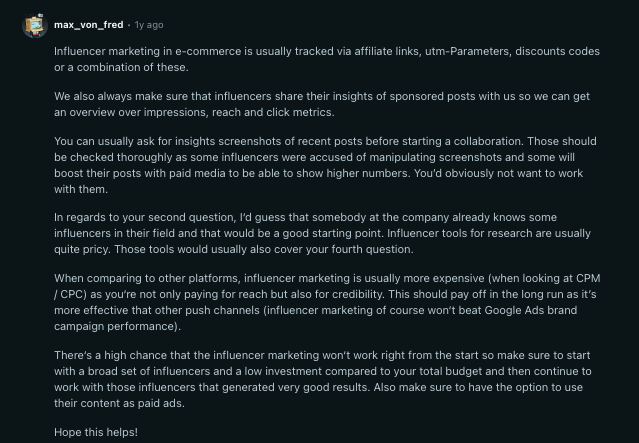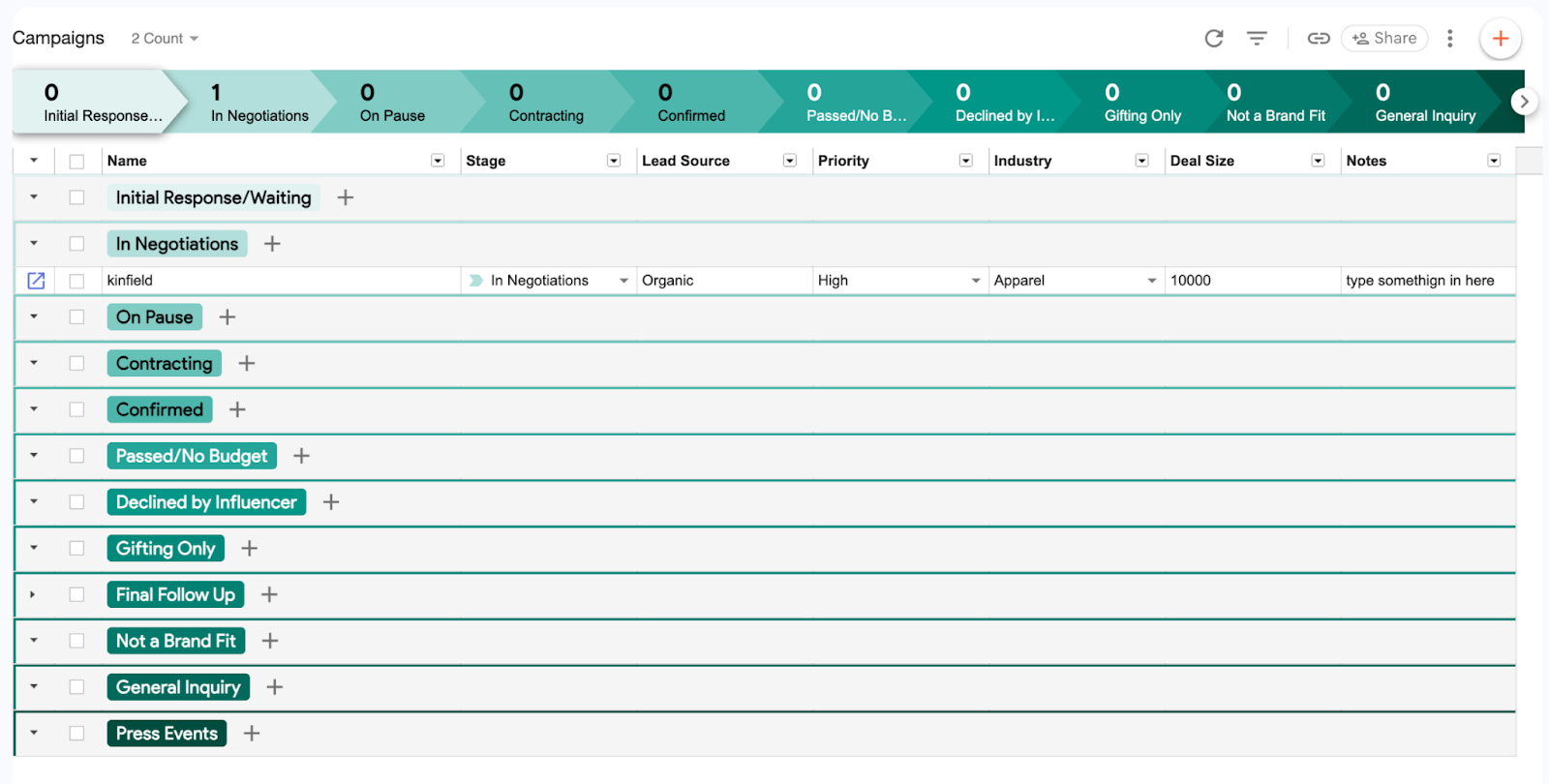Opening now...
Measuring Influencer Marketing ROI (with metrics, tools, and tips)
Influencer marketing has become a cornerstone of modern brand strategy — and with good reason. When done right, creators can add credibility, drive conversions, and generate content that performs across multiple channels.
But proving the ROI of those efforts? That’s where many marketers hit a wall.
At Streak, we work with a number of influencer and talent marketing agencies, and we've seen firsthand how difficult it can be to measure campaign performance in a way that accurately reflects both short-term results and long-term value.
To round out our perspective, we also scoured Reddit to see what marketers are saying candidly about their challenges and where they’ve found success in measuring ROI for influencer marketing.
In this guide, we break down how the challenges as well as how to measure and analyze the ROI of influencer marketing — from setting clear goals and picking the right metrics to using practical tracking tools and presenting results that actually resonate with stakeholders.
How do you measure influencer marketing ROI?
Start with clear goals, then track a mix of metrics like reach, clicks, and branded search. Use UTMs, promo codes, and influencer reports to attribute results. Combine numbers with qualitative wins to show full campaign impact.
What is influencer marketing ROI?
Influencer marketing ROI (return on investment) is a measure of the value generated from an influencer campaign compared to the resources spent on it. This includes direct results like sales and leads, as well as indirect impact like brand awareness, audience growth, content creation, and trust-building. Because influencer campaigns often aim for long-term value, ROI is typically evaluated through a mix of performance metrics, attribution tools, and qualitative outcomes.
{{cta-box}}
Why measuring Influencer Marketing ROI is so difficult
Measuring ROI in influencer marketing isn’t straightforward. While some challenges are common to all marketing channels, others are specific to the nature of creator campaigns — from the goals they aim to achieve to the data they rely on and how it’s reported.
Below, we’ve outlined five of the biggest reasons it’s so tricky to calculate ROI — especially if you’re aiming for more than just a sales number.
1. Goals can vary between campaigns
Some campaigns aim to boost awareness or engagement. Others focus on content production, lead gen, or direct sales.
Because success can mean different things in each case, there’s no single metric that fits all — and no easy way to compare performance across different initiatives.
2. ROI isn’t always immediate
Influencer marketing often aims to build long-term brand value, not just drive immediate purchases.
ROI can materialize weeks or months after a campaign ends, especially if a campaign is designed to build brand affinity rather than push a one-time promotion.
3. Attribution is rarely straightforward
Very few people click a promo code and make a purchase on the spot. More often, they’ll search for the brand later, revisit your site, or convert after a few different touchpoints.
This makes it hard to credit results to a specific influencer, post, or campaign — even if they played a major role in driving the outcome.
4. Tracking data across platforms is inconsistent
Each social platform provides different metrics — and even when they’re available, they aren’t always easy to standardize or compare.
For example, a "view" on TikTok might trigger more easily than a "watch" on YouTube, which usually requires more active engagement. That means marketers can’t just compare numbers side by side — they have to dig in and make sense of what those metrics actually represent on each platform.
5. Relying on creators to share critical performance data
Some of the most valuable performance metrics — like saves, reach, or story taps — are only visible to the influencer.
Unless creators share those screenshots, brands and agencies don’t always get the full picture.
How to set campaign goals for influencer marketing
Before you can measure ROI, you need to know what you're trying to achieve. Clear campaign goals are the foundation for meaningful reporting. They guide what you track, how you interpret results, and how you define success.

Goals will vary based on the brand’s broader strategy and the purpose of the campaign. Common influencer marketing goals include:
- Building brand awareness with a new audience
- Driving conversions or sales
- Generating user trust through social proof
- Creating reusable content for ads or email
- Increasing traffic or app installs
Each of these goals requires different metrics and tools to evaluate success. That’s why defining clear goals is essential — it keeps your ROI framework focused, relevant, and actionable.
Key metrics to measure influencer marketing campaigns
Once goals are defined, the next step is selecting the right metrics to track performance. To make ROI measurable, goals need to be paired with the right metrics.

It’s also important to time your tracking. Metrics like traffic, branded search, and engagement often spike while the campaign is live — so be sure to monitor performance during and immediately after the campaign window to capture the most relevant data.
To help connect the dots between campaign goals and performance tracking, here’s a breakdown of common influencer marketing objectives and the metrics typically used to measure them:
- Building brand awareness: impressions, reach, video views
- Driving conversions or sales: click-through rate (CTR), purchases, sign-ups, affiliate or promo code usage
- Generating user trust through social proof: likes, comments, shares, saves — strong engagement can signal relevance and authenticity
- Creating reusable content: number of assets created, performance of repurposed content in paid ads, email, or landing pages
- Increasing traffic or app installs: referral traffic, app install events, time on site, bounce rate, branded organic search traffic
Before launch, teams should align on what success looks like — and which metrics will define it. This ensures everyone is measuring the right outcomes and working toward the same goals.
How to track the impact of your influencer marketing campaigns
Understanding the value of an influencer campaign means using a combination of marketing tools—not just relying on one metric or software. From tracking direct conversions to measuring brand visibility, the right tools can help marketers see the full picture of a campaign's impact.
Here’s a look at some of the most effective ways marketers track influencer campaign results, grouped by the type of outcome they measure:
Brand awareness and visibility

- Social growth attribution: Track changes in followers and engagement on the brand’s social channels around campaign dates. Look for spikes in new followers, likes, and shares that align with influencer posts or campaign launches.
- PR pickup: Monitor media mentions and earned coverage driven by influencer campaigns.
- SEO lift: Track backlinks from influencer posts and monitor changes in branded search volume. To attribute this lift, use tools like Ahrefs or SEMrush to identify referring domains after a campaign, and compare search trend data over time using Google Trends or Search Console.
Conversions and sales
- Promo codes and affiliate links: Give each creator a unique promo code or affiliate link to track their performance. These tools help attribute sales directly to specific influencers and make performance-based compensation easier. They're also easy to implement with most e-commerce platforms and give both the brand and creator visibility into results.
- Lead-gen landing pages and forms: Create unique signup flows for influencers and track conversions from those sources
- Lead source surveys: This one's simple - ask how customers found you at sign-up or checkout.
Content performance
- Repurposing performance: Reuse influencer-created content in ads, emails, or landing pages and track how it performs compared to other creative assets.
Traffic and site behavior
- UTM parameters: Add UTM tags to influencer links for granular source tracking in analytics tools.
- Custom landing pages: Funnel traffic through dedicated URLs to isolate visits and traffic by creator.
- Traffic value benchmarks: Estimate how much you’d normally spend to get the same amount of traffic through ads. This gives you a baseline to compare the value of influencer-driven traffic.
Some teams also use broader models like “return on collaboration” — comparing the total value created (reach, content, traffic, conversions, social lift, etc.) against the total cost of the campaign. This holistic view helps quantify the full scope of impact and can be especially effective when presenting results to skeptical stakeholders.
Best practices to analyze and report on influencer marketing ROI
Clear, consistent reporting can make or break your ability to demonstrate ROI. Even with solid tracking, it's how you organize, interpret, and present that data that ultimately shows the value of your influencer program.
To help you analyze and report on your influencer campaigns more effectively, we’ve outlined actionable strategies that cover everything from setting expectations to uncovering insights that numbers alone can’t explain.
Match metrics to campaign goals
Different campaign goals require different measurement strategies. By reiterating goals and aligning your metrics with what the campaign is actually trying to achieve, you avoid surface-level reporting and ensure your analysis speaks directly to the campaign's priorities.
Use layered attribution models
Don’t rely on a single metric like promo codes or last-click attribution. Combine tracked data with surveys, page analytics, and qualitative insights.
Ask creators for performance screenshots

Some of the most important data — like reach, saves, or story taps — lives inside the influencer’s platform and isn’t visible to your team. Requesting screenshots of campaign performance helps fill these gaps and gives you a fuller picture of how the content performed.
Capture and include qualitative wins
Showcase content that sparked conversation, earned media coverage, or resonated with your audience. These wins may not show up in a spreadsheet — but they signal brand relevance, drive future engagement, and help justify investment when the numbers alone aren’t enough.
Use a CRM to manage campaigns and performance
A CRM is essential for organizing the many moving pieces in influencer marketing — from creator outreach to campaign delivery and client reporting.
Streak, a CRM built directly into Gmail, is a popular choice for influencer marketers because it works where teams already do.

Influencer marketing agencies and brands use Streak to build creator relationships, track deliverables, and manage campaigns right inside their inboxes.
Custom pipelines help teams keep tabs on campaign progress, while custom fields track important details like platform, post type, due dates, and rates. Shared pipelines and filtered views make it easy to segment results, collaborate with teammates, and report back to clients with confidence — all from within the inbox.
Segment results by campaign, creator, and platform
Use filters or saved views in your CRM to isolate key variables and identify what’s driving success. This helps you uncover patterns, spot underperforming areas, and tailor your strategy for future campaigns.
Tell a complete story in your reports
Pair performance metrics with context: what worked, what you learned, and how you’ll apply those insights to future campaigns.
Frequently Asked Questions about Influencer Marketing ROI
What metrics should I track to measure influencer ROI?
Influencer ROI is measured by metrics like engagement rate, click-through rate, conversions, and revenue compared to campaign cost. Many teams also track retention and customer lifetime value to understand long-term impact.
How do I attribute revenue to influencer campaigns?
You can attribute ROI by using tracking links, promo codes, or UTM parameters tied to each influencer. Tools like Streak CRM or Google Analytics help connect traffic and conversions directly to the campaign that generated them.
Is influencer marketing ROI achievable for smaller brands?
Yes. Smaller brands often see strong ROI through micro-influencers whose audiences are tightly aligned with their niche. Tracking these campaigns in a CRM like Streak makes it easier to compare cost versus revenue across different partnerships.
How long does it take to see ROI from influencer marketing?
Influencer marketing ROI can appear over time — engagement shows up quickly, while conversions and repeat purchases often take several weeks or months. Continuous tracking in Streak helps reveal patterns and long-term payoff.
What are common mistakes when calculating influencer ROI?
Many marketers overvalue vanity metrics like followers or likes and underestimate true costs such as product gifting or management time. Using Streak to centralize outreach and conversion data helps ensure every cost and result is accounted for.
How does Streak help measure and improve influencer ROI?
Streak CRM helps brands manage influencer relationships, track campaign performance, and tie communications directly to revenue outcomes — all from Gmail. With automations and integrated reporting, you can see which partnerships actually drive sales and scale the ones that perform best.
Track and improve influencer marketing ROI with Streak
Managing influencer relationships is just the first step — understanding their impact is what delivers real value. Streak helps you track influencer outreach, performance metrics, and ROI directly inside Gmail, so every campaign connects to measurable outcomes.
With features like native automations, customizable pipelines, and reporting dashboards, you can see which partnerships convert and focus your budget where it matters most.
Start your Streak free trial today to measure ROI more clearly and build stronger, data-driven influencer campaigns.
Subscribe to our blog
Stay in the loop with Streak’s latest features and insights.
Related articles
Learn more about using Streak CRM for Talent and Influencer Marketing Agencies.
Learn more about using Streak CRM for Talent and Influencer Marketing Agencies.



.png)


.webp)


